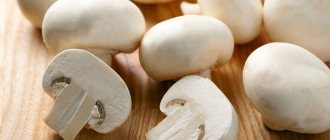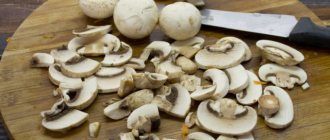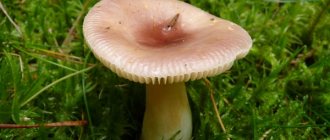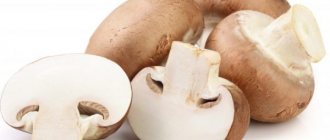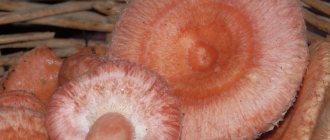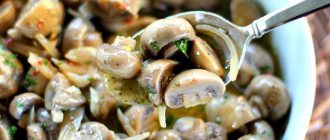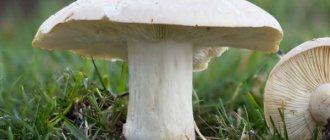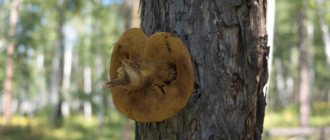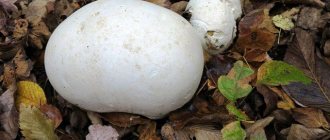Let's figure it out: Is it possible to eat black champignons under a hat?
The fact is that these mushrooms begin to turn black under the influence of certain factors. If the mushrooms are black inside, this is normal in some conditions. For example, if you fry mushrooms, they may turn black, but this does not mean that they have gone bad. But in other situations, blackness is a sign of spoilage of the mushroom, which, if eaten, can cause poisoning. That is why it is important to distinguish between these situations and know which blackened champignons can be eaten and which should be disposed of as quickly as possible.
Is it possible to eat blackened champignons?
The question arises: if the champignons are black under the cap, can they be eaten? As already written in the article above, such mushrooms can be eaten, except in situations where they are spoiled (signs of spoilage will be discussed in detail in the article below). Blackness on the surface of a fresh mushroom can occur for 3 reasons: storage at too low a temperature, unsealed packaging, old age and not freshness of the champignons.
And if the first 3 reasons do not lead to the accumulation of toxic and harmful substances, then old mushrooms can easily cause poisoning. The only thing is that if you stored the mushrooms in unsealed packaging or at a low temperature (they are fresh), then before further cooking, the champignons must be boiled for 10 minutes in water, which should be lightly salted.
Fresh champignons begin to deteriorate within 10-12 hours after they are separated from the mycorrhiza. This means that it is advisable to wash, peel and cook the mushrooms: pickle, boil, fry, stew, freeze, and so on - on the first day after collection. At the same time, storing fresh champignons for longer than 72 hours is strictly prohibited, even in the refrigerator. This must be taken into account when purchasing mushrooms in a store or from street vendors. Of course, you can forget the shelf life of champignons or the seller can deceive you, so it is extremely important to be able to identify signs of spoilage of champignons.
Possible complications
Champignon poisoning can cause serious complications. The most common consequences of intoxication are:
- Dehydration. During vomiting and diarrhea, the body loses a large amount of fluid. This leads to disruption of water-electrolyte metabolism. With dehydration, there is a sharp decrease in urination, tachycardia, weakness, and a drop in blood pressure.
- Gastritis. Due to damage to the stomach by toxins, inflammation of the organ mucosa occurs. In patients with chronic gastritis, exacerbation of the disease is possible.
- Pancreatitis. Against the background of intoxication, acute or chronic inflammation of the pancreas may occur. This disease is accompanied by girdle pain in the abdominal cavity and fever.
Due to the effects of harmful substances on the pancreas, chronic or acute pancreatitis worsens. When the stomach is irritated by toxins, gastritis may occur. In most cases, the victim needs the help of qualified specialists to minimize possible harm.
Poisoning with these mushrooms carries the risk of exacerbating diseases of the gastrointestinal tract: gastritis, inflammation of the intestinal mucosa, pancreas, kidney and liver failure, dehydration. When treating botulism, consequences for the central nervous system can be avoided.
Preventive measures for mushroom poisoning:
- purchasing products in stores responsible for product quality;
- tracking the shelf life of products, tightness and integrity of packaging;
- sufficient heat treatment of mushrooms during their preparation.
You should not collect mushrooms along highways and training grounds, in the absence of knowledge, so as not to confuse champignons with their inedible counterparts. To kill bacteria in home canning, you need to add a little vinegar to the brine - microbes do not like an acidic environment.
Mushrooms should not be consumed by nursing mothers, children under 3 years of age, during pregnancy, allergy sufferers, people with chronic renal failure and stomach ulcers.
The article has been approved
by the editors
Champignon poisoning, without timely treatment, can lead to disruption of the functioning of many human organs.
Complications:
- Dehydration due to frequent vomiting and diarrhea. A sign may be a reduced amount of urine produced, dry skin and mucous membranes, low blood pressure;
- Inflammation of the pancreas, which occurs against the background of poisoning of the human body with toxins;
- Irritation and inflammation of the mucous membranes of the stomach and esophagus as a result of processing harmful mushrooms;
Top articles: How to store wine at home in bottles or barrels -
Signs of spoiled raw champignons
What are the signs of spoiled champignons:
- Color: fresh champignons are white, matte or cream in color, sometimes pink; whereas a blackened mushroom (dark spots on the surface, and not on the inside of the cap) may indicate an expired shelf life, just as a glossy shade indicates spoilage of the mushroom.
- Cap: young champignons have a streamlined cap that may have scales; if yellow or black spots appear on it or the cap becomes flat, this indicates that such a mushroom should be disposed of and not prepared for food.
- The plate between the cap and the stem: a damaged plate indicates that the mushroom was collected a long time ago, and the expiration date has probably expired.
- Cut on the stem: if you made a cut at the lower end of the mushroom stem with a knife and found a dark and dry part, then the fruiting body is spoiled, and therefore the whole mushroom is too.
- Smell: champignons have a mushroom or anise smell that is difficult to confuse with something else; If there are odors of chemicals, dampness or rot, then such champignon must be thrown away as quickly as possible.
- Density: fresh champignons are always elastic and quite dense; but if you find a slippery and soft surface, then this directly indicates that the mushroom has long been spoiled.
- Pulp: if you cut a champignon into two parts, the inner surface of the mushroom should be light - this indicates the freshness of the product; whereas the darkened inner surface of the cap signals possible spoilage of the product.
If the mushroom has darkened only on the inside of the cap or between the stem and the cap, this does not indicate an expired shelf life. But if spots appear on the cap itself, including yellow and black ones, then such mushrooms must be disposed of. It is important to take into account that it is extremely rare that all signs of depravity appear at once. Usually they are combined in groups of 2-3. This means that if you find at least a couple of characteristic signs of an expired shelf life, then such champignons should be disposed of immediately.
Contraindications
Despite the huge amount of useful substances in the composition (vitamins and minerals), champignons can cause severe harm to human health. They contain chitin, which the body is not able to digest, so it is forbidden for children under 12 years of age to consume mushrooms.
Considering that the amount of chitin is high (about 7% of dry matter), it can cause problems in the gastrointestinal tract. For this reason, try to eat mushroom fruiting bodies no more than 3 times a week.
Storage rules
Now you can answer the question: is it possible to eat blackened champignons? Blackening is not always a sign of depravity. For example, if you freeze mushrooms, they will turn black over time. The same thing will happen if you fry champignons or boil them incorrectly. To eliminate the risk of poisoning from spoiled mushrooms, it is necessary to store mushrooms correctly. Firstly, after picking, the mushrooms need to be washed in a bowl of water and peeled. Secondly, the mushrooms need to be fried, boiled or stewed.
This must be done on the same day that the champignons were collected, or, in extreme cases, the next day. If you need to store mushrooms for a longer period, you can salt, freeze or dry them. The best recipes for preparing champignons can be found on this site, where you can also find specific storage rules. Generally speaking, champignons should be kept in the refrigerator, basement or other places where the temperature is 1-5 degrees Celsius.
Video: how to properly store champignons
For clarity, I recommend watching a video on how to properly store champignons. It’s worth noting right away that not everything here is as easy and transparent as it might seem at first glance. After all, you need to take into account a number of factors: method of preparation, temperature conditions, storage containers, additional ingredients in the composition, and so on. The author of the video below talks about all this in detail. In addition, the video explains how to properly collect champignons in the forest, as well as some secrets of selling surplus mushrooms. Turn on video, sound and absorb useful information. Enjoy watching!
Taste qualities
Honey mushrooms are valued for their exceptional scent and ability to collect large quantities in a short time.
Young mushrooms have strong and elastic white flesh. An edible adult honey fungus loses its ability to retain juices in the fruiting body. Therefore, its leg often dries out, the flesh becomes whitish-gray or yellowish, loose.
Young and adults have the same taste
Both young and adult mushrooms differ little in taste. In some European countries, gourmets even prefer overgrown ones - the hardness and fibrousness of the pulp appeals more to their tastes. When cooking, do not use rotten, wormy or false specimens, because... they will give the dish an unpleasant smell and a bitter aftertaste.
In what form should you eat champignons to avoid getting poisoned by them?
Have your mushrooms turned black and are you wondering if you can eat them? In this case, it is necessary to check them for other signs of an expired shelf life, which were discussed in the article above. Once again, I would like to note that if dark black spots appear on the cap or stem of the mushroom, then such champignons should definitely not be eaten. If it turns black only under the cap, then the mushrooms should be boiled for 10 minutes in salted water. And only after that prepare further: boil, fry, stew, freeze, and so on. This will ensure that you do not get food poisoning from mushrooms.
Further treatment
Doctors who arrive on call must assess the patient’s condition. Stabilizing measures are being carried out. Doctors need to return the cardiovascular system to proper functioning and normalize the patient’s breathing. Then you need to:
- administer medications to relieve nausea and vomiting;
- eliminate pain syndrome with antispasmodics;
- replenish the water balance with a dropper.
Once the patient is stabilized, hospitalization may be required. Further treatment takes place in a hospital setting, in the intensive care unit under the supervision of doctors. Botulism requires urgent administration of serum.
Sources:
https://fermer.blog/bok/griby/sedobnye-griby/13638-prigotovlenie-potemnevshih-shampinonov.html https://fermilon.com/sad-i-ogorod/griby/pochemu-shampinony-v-razreze-vnutri -chernye-cherneyut-pri-zharke-prichiny-mozhno-li-upotreblyat-v-pischu.html https://otravilsya.com/pishhevye/gribami-rasteniyami/shampinonami/
Symptoms of champignon poisoning
If a person is poisoned by champignon, the consequences and symptoms will not take long to appear. On average, after 4-6 hours a person begins to feel a stomach ache, feel sick, and sometimes have diarrhea. As with any other poisoning, some signs of intoxication occur. The most common are sweating, headache, fever, fatigue, weakness, rapid heartbeat and breathing. To avoid serious consequences and undergo rehabilitation as quickly as possible, you need to quickly provide professional medical assistance. To do this, the victim must be taken to the appropriate hospital: call an ambulance or drive yourself to the clinic by car.
First aid
First of all, you need to call a doctor. Further assistance to the victim consists of gastric lavage. He needs to be given a lot of clean water to drink (at least 4 liters). If a person develops strabismus, it is better to prepare a manganese solution (1.5 liters of water and 0.5 tsp of manganese). The patient should drink the medicine in small sips. It is necessary to drink the solution until food appears in the vomit.
If the victim does not have diarrhea, then it must be induced. To do this, you need to give him a weak saline solution with a small amount of laxative to drink. After this, let him drink activated carbon. The norm is 1.5 tablets per 1 kg of body.
After diarrhea, vomiting and elevated body temperature, dehydration begins. In such cases, in the hospital the patient is given IVs with special solutions. Since it is difficult to find them at home, it is allowed to use ordinary strong tea, which the victim must drink until the doctor arrives.
So, now you know what the signs and causes of darkening of champignons are. It is important to store mushrooms correctly so that they not only do not lose their beneficial properties, but also do not disrupt the functioning of internal organs. Therefore, if they begin to darken, then they can no longer be consumed. At the slightest manifestation of poisoning, you should immediately consult a doctor so as not to provoke death. Spoiled food should always be thrown away.
Why do champignons turn black?
Champignons can turn black for several reasons: due to spoilage of the product, due to heat treatment, due to improper storage, due to the ripening of the mushroom. By the way, slightly blackened champignons can easily be confused with toadstool, so I recommend watching the video: how to distinguish a poisonous mushroom from a good champignon - in the article below. Well, is it possible to eat blackened mushrooms and under what conditions will be discussed later in the article. I recommend reading all the information provided - many useful and interesting facts await you.
Why do champignons have black plates under the cap?
Young champignons have a white or beige color, which attracts buyers. But if black plates are found under the cap, this does not mean that the seller is trying to sell damaged goods. The fact is that blackness under the cap indicates that the mushrooms are ripe (the same effect can be observed if the champignons lie in the refrigerator or freezer for some time). But, if you are picking mushrooms in the forest and see that there are pronounced black plates under the cap, then it is better to pass by such a champignon, since such mushrooms are already overripe and their taste leaves much to be desired. Let me remind you once again that champignons must be fried or subjected to other heat treatment before eating.
Why are champignons black inside?
When cutting into mushrooms, you can often notice a slight blackness inside - this is normal. Since the mushrooms, after being separated from the mycorrhiza, begin to darken under the influence of air. But if there is no white shade left on the cut of the mushroom, and blackness takes up all the space (or almost all of it), then it is better to recognize such a mushroom as spoiled and throw it away. You should get rid of the champignon without hesitation if you notice an unpleasant odor or the smell of mold, while the plates under the cap are very black, and the mushroom itself, when cut, is dark in color (close to black), and is also wet to the touch.
Why do champignons turn black when fried?
When people who fry champignons for the first time discover that the mushrooms have turned black, they often get scared and throw out what they think are spoiled products. But in fact, blackening of any mushrooms during frying is normal. True, only under this condition that before heat treatment the champignons looked white or with small darkened spots on the cut. Therefore, if you are sure that the champignons were normal before frying, but darkened during heat treatment, then this process is natural for almost all types of mushrooms.
Why did the champignons turn dark after defrosting?
Usually, champignons darken after defrosting if they were not frozen correctly (a video with freezing rules can be seen in the article above): most often the temperature in the freezer is too low, or the mushrooms were stored in unsealed packaging. If, after defrosting, there is no sticky mucus on the mushrooms, large bright black spots, a bad and unpleasant odor, or a rotten spore-bearing layer, then such mushrooms can be eaten without fear. Don’t forget to prepare them first: fry, stew, bake or steam – on our website you can find a huge number of different DIY champignon recipes.
Spoilage of dried mushrooms
You can determine that dried mushrooms have gone bad by the following signs:
- they became damp and moldy;
- emit a rotten smell;
- when touched, they crumble and turn into dust;
- contain larvae of parasites (exudations from worms are noticeable - holes and passages).
This product must be recycled.
To be sure that dried champignons are of high quality, you should pay attention to:
- color: it should be light brown;
- density: hard to the touch.
You can only buy dried champignons from a seller you know well, whose services you have been using for a long time.
To summarize
Now you can answer the question: is it possible to eat blackened champignons? There are rules that have been described in detail in this article. In short, there should be no dark spots on the cap and legs, no strange or unpleasant odor, and the flesh and color of the mushroom should be normal.
It should be borne in mind that mushrooms may darken in some situations, which were also discussed in detail in this article. To quickly find the necessary information, I recommend using the content located at the beginning of the article. Be sure to leave your thoughts and questions regarding the topic in the comments. We will promptly respond to the most interesting of them. Bon appetit, see you soon!
Species table
| Name | From Latin | Category |
| Elegant | Agaricus comtulus | good edible mushroom |
| Tabular | Agaricus tabularis | conditionally edible mushroom |
| Big Forest | Agaricus mediofuscus | good edible mushroom |
| Carbolic | Agaricus placomyces Peck | inedible non-toxic mushroom |
| Crooked | Agaricus abruptibulbus | good edible mushroom |
| Field | Agaricus arvensis | good edible mushroom |
| Augustovsky | Agaricus augustus | good edible mushroom |
| Benesha | Agaricus benesii | good edible mushroom |
| Bernard | Agaricus bernardii | good edible mushroom |
| Cultivated | Agaricus bisporus | excellent edible mushroom |
| Double ring | Agaricus bitorquis | good edible mushroom |
| Lugovoy | Agaricus campester | good edible mushroom |
| Dark red | Agaricus haemorrhoidarius | good edible mushroom |
| Large-spored | Agaricus macrosporus | excellent edible mushroom |
| Motley | Agaricus meleagris | inedible non-toxic mushroom |
| Blushing | Agaricus semotus | conditionally edible mushroom |
| Forest | Agaricus silvaticus | good edible mushroom |
| Steam | Agaricus varoparius | good edible mushroom |
| Yellow-skinned | Agaricus xanthodermus | toxic mushroom |
| Redhead | Agaricus xanthodermus | toxic mushroom |
Is it possible to eat champignons with black plates?
How to understand that champignons have spoiled and should not be eaten
How many different dishes can be prepared from mushrooms? These can be both everyday dishes and holiday ones. But since not all people like to go on a quiet hunt, mushroom products are often purchased at a nearby store or market.
Usually the choice is made on beautiful white champignons, which attract with their elasticity and aroma. But only fresh products are not always sold. Many careless sellers, under the guise of fresh mushrooms, sell a product that is not of the first freshness.
How to understand that champignons have spoiled and are no longer suitable for eating.
How to tell if champignons have gone bad
Champignons that are grown under artificial conditions are considered so harmless that they can be eaten even raw. But the main condition for consuming thermally unprocessed mushrooms is their freshness. If the mushrooms are of dubious quality, then this will not only not bring benefit to the body, but can also cause harm.
Stale and old mushrooms produce toxic substances that lead to intoxication and malfunction of important organs and systems.
To determine the freshness of champignons, you should pay special attention to the following details:
- Color – fresh mushrooms are white or slightly pinkish. You can also check for freshness by its characteristic matte shine. When the color of the mushrooms is dark and there is no matte shine, this indicates overripeness or prolonged storage of the product.
- Cap – young and recently cut mushrooms will have a streamlined, velvety, smooth or slightly scaly cap. If there are yellow, brown or black spots on the cap, this indicates spoilage of the product. Old champignons are recognized by their flat and large cap.
- The film between the stem and the cap is whitish and dense in fresh and young fruits. If the film is damaged, it means that the mushroom was picked a long time ago and it is advisable not to eat it.
- The plates under the cap - in young and fresh mushrooms the plates are elastic and white-pinkish; in missing mushrooms the plates become dark and loose.
- Stem cut - on spoiled champignons, the cut looks dark and dry.
- Smell – stale mushrooms begin to exude the aroma of dampness and rot.
- Fruit density - fresh mushrooms are always elastic and quite hard. Slippery champignons indicate the beginning of putrefactive processes.
It is advisable to purchase champignons only in designated places. In stores, you can always ask for a quality certificate for the product, which, among other things, will indicate the date of collection and delivery.
All mushrooms, like a kind of sponge, absorb radiation, heavy metal salts and toxins
This is why it is so important that champignons are grown in environmentally friendly conditions.
Is it possible to eat expired champignons?
Often in stores and markets you can see discounted champignons that have already darkened.
Sellers invite customers to purchase such goods at a reduced price, assuring that after heat treatment such mushrooms will be indistinguishable from fresh products.
So is it possible to eat expired champignons? The answer will be unequivocal: you cannot eat such products, as you can get poisoned.
Store-bought mushrooms often contain higher amounts of chitin, phosphorus and various acids. The longer the product is stored, the more toxic all these substances become.
How to tell if champignons have gone bad in the refrigerator
Champignons can also spoil if stored in the refrigerator for a long time. But here it’s worth knowing exactly what signs indicate that the product should be thrown in the trash. So, even if stored in the refrigerator for a short time, the mushrooms may darken a little due to temperature changes, but this does not mean that they need to be thrown away.
A product spoiled in the refrigerator can be identified by a number of characteristic signs:
- The mushrooms became unpleasantly slippery.
- There is a distinct smell of rot or dampness.
- Black spots appeared on the surface of the cap.
- The plates under the cap lost their elasticity and turned black.
It is not recommended to cook slippery and darkened champignons. Old mushrooms contain large quantities of toxic substances, which do not disappear even with heat treatment. After eating such foods, you may experience indigestion.
Both adults and children love champignons. But it is worth considering that this product is a delicacy, so it should be in limited quantities in the children's diet. To avoid poisoning from champignons, you need to buy only fresh and young mushrooms.
Density
Good, fresh champignons always have a firm, elastic body. If it is soft, you definitely cannot eat such champignons - this is a sign that the mushrooms are already significantly spoiled.
Home greenhouse made from bottles. How to make a convenient place for cucumbers and tomatoes
There is intrigue: what you liked about the TV series “Crime 2”
Suitable for both the living room and the kitchen: a do-it-yourself corrugated table
However, loss of elasticity is usually not the only sign of spoilage of the mushroom. Most likely, to make sure that it is not fresh, you won’t even have to touch the caps.
Sticky surface
Sticky caps are another sign of spoiled champignons. This symptom can appear in two cases: either when the mushrooms have been lying for too long in conditions unsuitable for storing mushrooms, or after defrosting. In both the first and second cases, the use of such mushrooms is fraught with problems with the health of the digestive tract.
Don't throw away old jeans. They will make a comfortable bag: follow the instructions
“Delighted with the script”: Boris Dergachev admitted his desire to play in “Slave”
Cheese, cottage cheese and other foods you shouldn’t start your day with: complete list
Good mushrooms have a completely dry and velvety surface of the caps, a uniform white or cream color; any gloss is a sign of spoilage, which nothing can be done about (even long heat treatment will not help).
Healing properties
The royal champignon has a number of beneficial properties that have a beneficial effect on the human body when consumed regularly.
- Activates the functioning of the digestive organs and increases appetite.
- Prevents the development of blood clots.
- Increases the elasticity of the walls of blood vessels, reducing the risk of heart attacks and preventing atherosclerosis.
- Normalize the activity of the heart muscle and the functioning of the respiratory system.
- Acts as an anti-inflammatory agent.
- Optimizes brain activity, activating mental processes.
- Removes toxins, slowing down the aging process.
Contraindications
Mushrooms are difficult to digest
- Inflammatory processes in the organs of the digestive system (pancreatitis, stomach ulcers, gastritis, gastric disorders).
- Tendency to flatulence.
- Cholecystitis.
- Enterocolitis.
Mushrooms are hard-to-digest foods and are poorly digested by the human body. They should be included in children's diets with due caution, preferably limited to children under 12 years of age.
According to general recommendations, the frequency of use should not exceed 3 times a week.
Ingredients:
Sunday, March 31, 2022
How to fry champignons in a frying pan so that they turn out appetizing, rosy, aromatic and truly tasty? There really are secrets in cooking champignons - you just need to remember them and put them into practice. And then prepare salads with champignons, and potatoes with them... whatever your heart desires!
Today I suggest frying fresh mushrooms - in my opinion they turn out perfect. Of course, you can also take frozen ones: then let the champignons thaw, after which they must be squeezed out (as a rule, such mushrooms are sold in the form of plates).
In general, you can fry absolutely any number of champignons (I indicated 300 grams just as an example). It is important to do this in a large and wide container so that the mushrooms have enough space. If you need a lot of mushrooms, fry them in batches.
Yes, the main thing is to process it if it is meat or expired kefir for pancakes.
27.41%
No, it is very dangerous and not useful.
37.34%
If the products have fungus or mold, then we throw them away; if they are a couple of days past their expiration date, we use them for food, even without heat or other treatment.
35.25%
Voted: 1339
I will be very glad if after reading this recipe you no longer ask questions: Why are my mushrooms not fried, but stewed? Why are fried champignons not brown, but gray? Fried champignons are tasteless: what did I do wrong?
